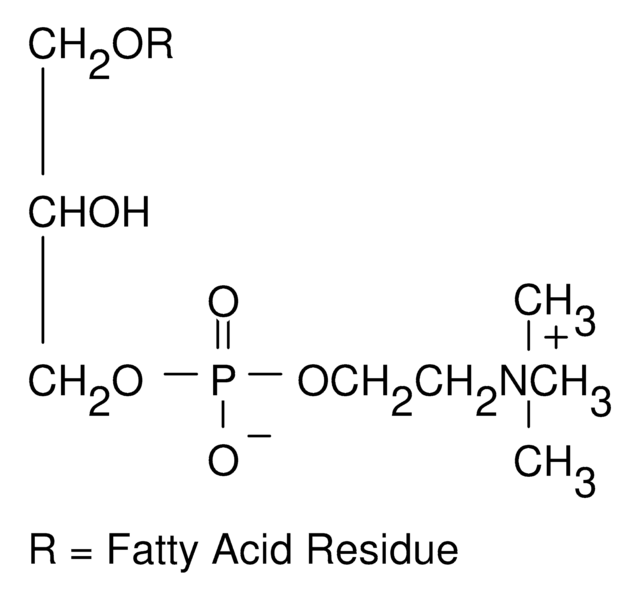Wichtige Dokumente
L1881
1-Oleoyl-sn-glycero-3-phosphocholin
synthetic, ≥99%
Synonym(e):
(7R,18Z)-4,7-Dihydroxy-N,N,N-trimethyl-10-oxo-3,5,9-trioxa-4-phosphaheptacos-18-en-1-aminium-4-oxid, inneres Salz, 1-(9Z-Octadecenoyl)-sn-glycero-3-phosphocholin, 1-cis-9-Octadecenoyl-sn-glycero-3-phosphocholin, 1-Oleoyl-2-hydroxy-sn-glycerol-3-phosphocholin, 1-Oleoyl-sn-glycero-3-phosphorylcholin, 3-sn-Lysophosphatidylcholin, 1-oleoyl, L-γ-Oleoyl-α-lysolecithin, Lysolecithin, Oleoyl, PC(18:1(9Z)/0:0), PC(18:1/0:0)
About This Item
Empfohlene Produkte
Biologische Quelle
synthetic
Qualitätsniveau
Assay
≥99%
Form
powder
Funktionelle Gruppe
phospholipid
Lipid-Typ
phosphoglycerides
Versandbedingung
ambient
Lagertemp.
−20°C
SMILES String
O[C@](COP([O-])(OCC[N+](C)(C)C)=O)([H])COC(CCCCCCC/C=C\CCCCCCCC)=O
InChI
1S/C26H52NO7P/c1-5-6-7-8-9-10-11-12-13-14-15-16-17-18-19-20-26(29)32-23-25(28)24-34-35(30,31)33-22-21-27(2,3)4/h12-13,25,28H,5-11,14-24H2,1-4H3/b13-12-/t25-/m1/s1
InChIKey
YAMUFBLWGFFICM-PTGWMXDISA-N
Suchen Sie nach ähnlichen Produkten? Aufrufen Leitfaden zum Produktvergleich
Verwandte Kategorien
Anwendung
Lagerklassenschlüssel
11 - Combustible Solids
WGK
WGK 3
Flammpunkt (°F)
Not applicable
Flammpunkt (°C)
Not applicable
Persönliche Schutzausrüstung
Eyeshields, Gloves, type N95 (US)
Hier finden Sie alle aktuellen Versionen:
Besitzen Sie dieses Produkt bereits?
In der Dokumentenbibliothek finden Sie die Dokumentation zu den Produkten, die Sie kürzlich erworben haben.
Kunden haben sich ebenfalls angesehen
Unser Team von Wissenschaftlern verfügt über Erfahrung in allen Forschungsbereichen einschließlich Life Science, Materialwissenschaften, chemischer Synthese, Chromatographie, Analytik und vielen mehr..
Setzen Sie sich mit dem technischen Dienst in Verbindung.















